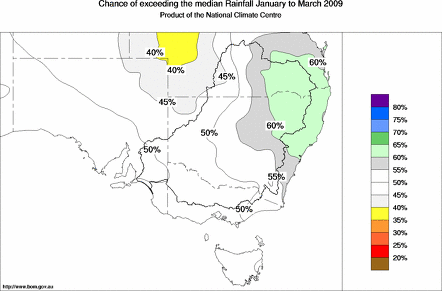| Southeastern Aust Seasonal Rainfall Outlook: probabilities for January to March 2009, issued 17th December 2008 | |||||||||
Wet start to the year favoured for northeastern NSWThe outlook for rainfall during the first quarter of 2009 (January to March) shows a moderate shift in the odds favouring wetter than normal conditions over northeastern NSW. For the remainder of southeastern Australia the odds favouring a wetter or drier first quarter of 2009 are even. Over much of northeastern NSW the chances of January to March totals exceeding the 3-month median rainfall is around 60% (see map). This means for every ten years with ocean patterns like the current, about six years are expected to be wetter than average while about four years are expected to be drier. Over the remainder of NSW, South Australia, Victoria and Tasmania the chances of exceeding the seasonal median are between 45% and 55%. This means the chances of being wetter than normal in these areas are about the same as the chances of being drier. The pattern of seasonal rainfall odds across Australia is mainly a result of continued warmth in the central Indian Ocean. The Pacific Ocean has not contributed significantly to this pattern (see below however, for a full discussion of the current state of the Pacific Ocean and ENSO). 
Outlook confidence is related to how consistently the Pacific and Indian Oceans affect Australian rainfall. During January to March, history shows this effect to be moderately consistent over coastal NSW and weak to moderately consistent over the northeastern inland of NSW, parts of Tasmania, as well as the Victorian coastal districts west of Port Philip and the west coast and southern part of the northwest pastoral districts of SA. However, confidence is only weakly to very weakly consistent over much of the south and southwestern NSW, most of Victoria, SA and parts of Tasmania (see background information). In these areas where outlook confidence is not high caution should be used when interpreting these outlooks. The tropical Pacific Ocean remains ENSO-neutral. Sea surface temperatures across most of the equatorial Pacific are near normal, however, cool sub-surface temperatures persist from the dateline to the South American coast and the trade winds are now stronger than normal across most of the basin. The SOI remains positive at approximately +13 for the 30 days ending 14 December. Most international computer models indicate that neutral conditions are likely to continue through summer and autumn, however, two models predict cooling. For routine updates and comprehensive discussion on any developments please see the ENSO Wrap-Up. | |||||||||
Click on the map above for a larger version of the map. Use the reload/refresh button to ensure the latest forecast map is displayed. | |||||||||
|
More information on this outlook is available Monday to Friday from 9.00am to 5.00pm local time by contacting the Bureau's Climate Services sections in Queensland, NSW, SA, Victoria and Tasmania at the following numbers:
| |||||||||
THE NEXT ISSUE OF THE SEASONAL OUTLOOK IS EXPECTED BY 22nd January 2009 Corresponding temperature outlook November 2008 rainfall in historical perspective September to November 2008 rainfall in historical perspective | |||||||||
Background Information
| |||||||||









